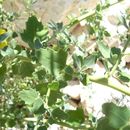Distribution in Egypt
provided by Bibliotheca Alexandrina LifeDesk
- author
- BA Cultnat
- provider
- Bibliotheca Alexandrina
Global Distribution
provided by Bibliotheca Alexandrina LifeDesk
Europe, Mediterranean region, Africa, Asia, introduced into north America.
- author
- BA Cultnat
- provider
- Bibliotheca Alexandrina
Habitat
provided by Bibliotheca Alexandrina LifeDesk
Weeds of cultivation and waste ground.
- author
- BA Cultnat
- provider
- Bibliotheca Alexandrina
Life Expectancy
provided by Bibliotheca Alexandrina LifeDesk
Annual or short-lived perennial.
- author
- BA Cultnat
- provider
- Bibliotheca Alexandrina
Comments
provided by eFloras
Many previous reports of Chenopodium opulifolium in North America were based on misidentifications. Determining its present occurrence and exact distribution in the New World requires special study.
- license
- cc-by-nc-sa-3.0
- copyright
- Missouri Botanical Garden, 4344 Shaw Boulevard, St. Louis, MO, 63110 USA
Description
provided by eFloras
Stems erect to ascending, usually much-branched, 0.2-0.7(-10) dm, densely farinose. Leaves non-aromatic; petiole 0.5-2(-3) cm, shorter than or equaling leaf blades; blade ovate to rhombic-ovate, 1-3.5(-4.5) × 1-3(-4) cm, base broadly cuneate to abruptly truncate, distinctly 3-lobed, margins dentate to ± entire, apex obtuse (rarely subacute), grayish, usually densely farinose on both surfaces. Inflorescences glomerules in terminal and lateral compound spikes, 2-19 cm; glomerules subglobose, 3-4 mm diam.; bracts absent. Flowers: perianth segments 5, distinct nearly to base; lobes ovate, ca. 1 × 1.1 mm, apex obtuse, densely farinose, keeled, covering fruit at maturity; stamens 5; stigmas 2, 0.2 mm. Utricles depressed-ovoid; pericarp nonadherent, smooth to indistinctly granulate. Seeds lenticular to compressed-subglobose, 0.8-1.25 mm diam.; seed coat black, smooth or faintly reticulate. 2n = 54.
- license
- cc-by-nc-sa-3.0
- copyright
- Missouri Botanical Garden, 4344 Shaw Boulevard, St. Louis, MO, 63110 USA
Distribution
provided by eFloras
introduced; Ont.; Ill., Ind., Md., N.C., Pa.; native s Europe, introduced occasionally in other parts of the world.
- license
- cc-by-nc-sa-3.0
- copyright
- Missouri Botanical Garden, 4344 Shaw Boulevard, St. Louis, MO, 63110 USA
Flowering/Fruiting
provided by eFloras
Fruiting late summer-fall.
- license
- cc-by-nc-sa-3.0
- copyright
- Missouri Botanical Garden, 4344 Shaw Boulevard, St. Louis, MO, 63110 USA
Habitat
provided by eFloras
Disturbed soils in open habitats; 0-200m.
- license
- cc-by-nc-sa-3.0
- copyright
- Missouri Botanical Garden, 4344 Shaw Boulevard, St. Louis, MO, 63110 USA
Chenopodium opulifolium: Brief Summary
provided by wikipedia EN
Chenopodium opulifolium, the seaport goosefoot, is a species of annual herb in the family Amaranthaceae (pigweeds). They have a self-supporting growth form. They are associated with freshwater habitat and have simple, broad leaves. Individuals can grow to 67 cm tall.
- license
- cc-by-sa-3.0
- copyright
- Wikipedia authors and editors


![]() This article incorporates text from a free content work. Licensed under CC0 (license statement/permission). Text taken from Chenopodium opulifolium, . Encyclopedia of Life.
This article incorporates text from a free content work. Licensed under CC0 (license statement/permission). Text taken from Chenopodium opulifolium, . Encyclopedia of Life.